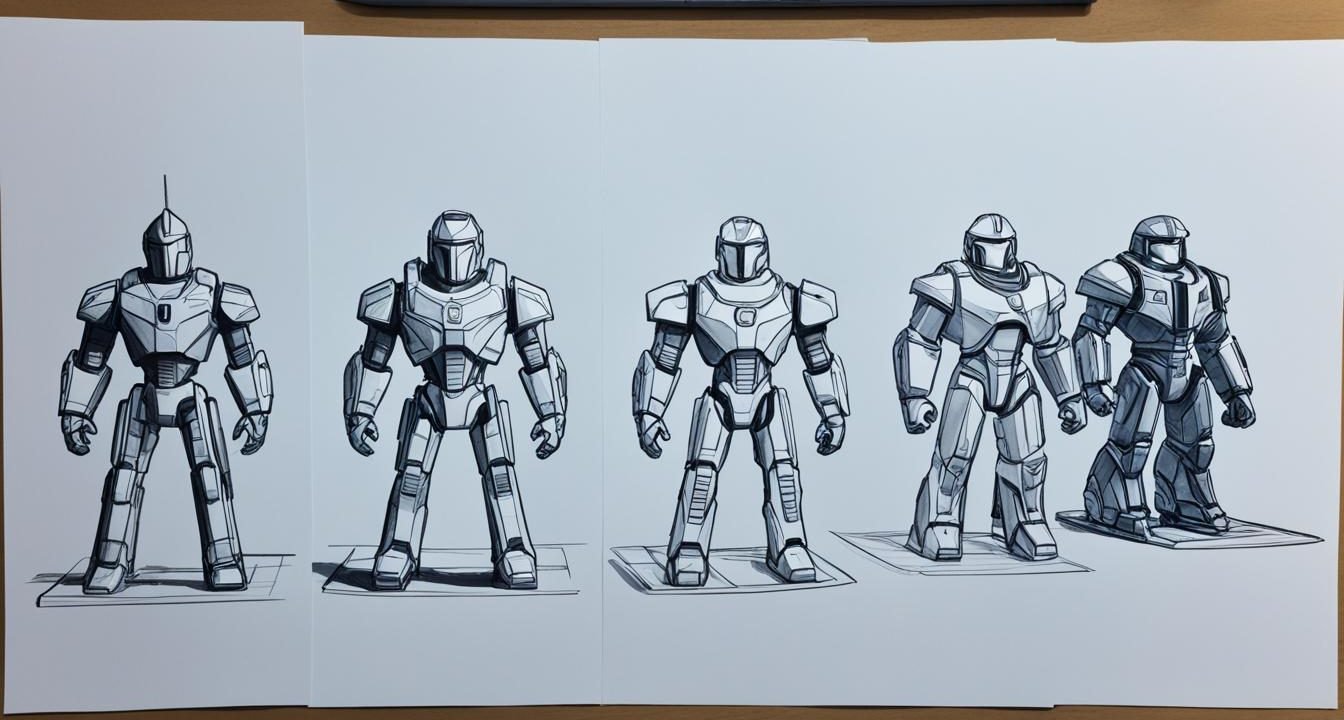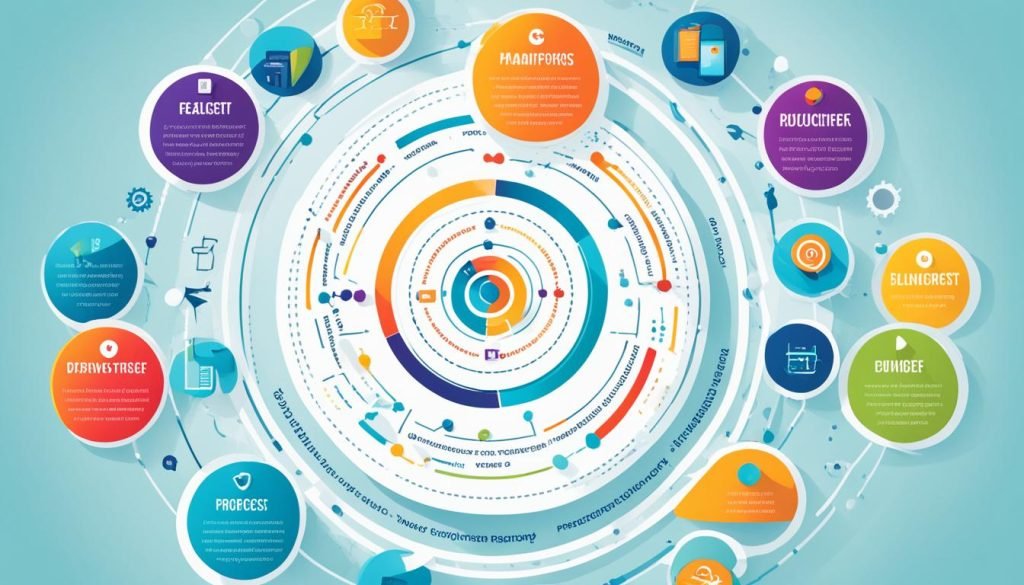
The product development process takes a product from just an idea to being sold. It breaks down each step clearly. This way, all teams work together well from the start to the end.
The first big step is to see what the market needs. You figure this out by knowing what problem customers have and what they want. Then, you look at what other companies are doing to stand out and be different.
Finding ideas is fun and involves a lot of thinking and sharing. Organizations use special ways to be quick and flexible. This helps in meeting what customers need faster.
After finding a good idea, a plan is made to make the product a reality. This plan keeps everyone on the same page. It makes sure the product will be what people want and need.
Next, making a model and testing it is really important. This model is not the final product but a step towards it. Testing it helps make sure it is what customers expect and fixes any problems early on.
Key Takeaways:
- The product development process involves six stages: market need identification, competition research, idea generation, product roadmap development, prototyping, and testing.
- Agile methodology and lean startup principles promote flexibility and adaptability in product development.
- Prototyping and user research are crucial for gathering feedback and iterating on the product design.
- Design thinking emphasizes empathy, ideation, prototyping, and testing, ensuring user-centered product development.
- A product roadmap helps align departments and ensures efficient resource allocation.
Stage 1: Idea Generation (Ideation)
Idea generation is the first step in making new products. It’s about thinking of new, smart ideas. These ideas come from looking at what people need and want but don’t have yet. This helps companies find chances to make new products that will actually help people.
It’s important to really look at who will buy your product and what they like. This is called the target market. By knowing your target market well, you can make a product that they will love. This leads to success because you’re giving people what they’ve been wishing for.
Studying what’s already out there is also key. This means checking out other products similar to yours. Figuring out what makes yours different – better – is a big deal. It helps you make something that really stands out or improves on what’s already available.
Deciding what your product will do is crucial too. You need to think about what features people will really care about. This ensures your product meets the market’s wants or needs. And that’s essential for success.
Doing a SWOT analysis can also be very useful in this stage. This looks into your product’s strengths, weaknesses, the opportunities out there, and any threats. Knowing these things can help make your product even better. It can also help you prepare for any tough challenges.
Using creative methods like SCAMPER is great for making ideas even better. SCAMPER is all about thinking in new ways. It stands for Substitute, Combine, Adapt, Modify, Put to another use, Eliminate, and Reverse. This method sparks creativity and innovation, making ideas stronger.
Companies use idea generation to build a full plan for their new product. This plan shows what the product is about and why it’s needed. It helps everyone understand the goals clearly.
Check out the table below to see the key points of the idea generation stage:
| Aspect | Considerations |
|---|---|
| Target Market | Determine the demographics, interests, and pain points of the target market. |
| Existing Products | Evaluate competitors and identify gaps in the market. |
| Functionality | Determine the desired features and functionalities of the new product. |
| SWOT Analysis | Analyze the strengths, weaknesses, opportunities, and threats related to the product concept. |
| SCAMPER Method | Utilize the SCAMPER method to stimulate creative thinking and refine ideas. |
Stage 2: Product Definition
After we come up with the product idea, the next big step is defining the product. This stage is very important. It helps set our strategy and the first steps towards creating and selling the product. Let’s dive into the important parts of product definition.
Business Analysis
Before anything else, we must fully examine our business. This analysis looks at how we will sell and where, it sees who we will be competing against, and studies market trends. It’s crucial for knowing our customer and finding ways to stand out.
Value Proposition
The value proposition explains why our product is the best choice. It shows what makes our product special and convinces people to choose it. Getting this message just right is key to our marketing success.
Success Metrics
We need to know how we’ll measure our product’s success. The measures we pick depend on what the product is and our business goals. Often, we look at sales, getting new customers, how happy customers are, and our share of the market.
Marketing Strategy
A strong marketing plan is crucial. It ensures our product is seen and wanted by the right people. The plan includes knowing who our ideal customers are, choosing the best ways to reach them, and what messages to send to them.
For example, let’s look at WearableCo, a company making fitness gadgets. They began by closely examining their business to spot their target audience and understand what customers really wanted. They then focused on what made their wearables stand out, like cool features and working great with top fitness apps. Their marketing plan used influencers and smart online ads. This is the power of a solid product definition.
Investing in clearly defining a product pays off big. Companies like WearableCo show us the way. They make sure their path is clear and everything they do meets both the market’s and customer’s expectations.

Stage 3: Prototyping
Prototyping is key to making a product. It starts with lots of research and noting down the product’s details. It checks if making the product is doable and looks at the market’s risks. Having a game plan helps teams steer through any problems they face, making sure their product does well.
Feasibility analysis looks at if the product can actually be made within limits like time and money. It pinpoints any difficulties early and suggests changes. This is crucial for the product’s success.
Looking at market risks is just as important. It means checking out the competition and seeing what might stand in the product’s way. Doing this research helps teams adjust their plans so they can deal with uncertainties in the market.
Also, making a detailed development plan is a must. This plan spells out how the product will be made, who’s in charge of what, and when it all needs to happen. With a clear plan, resources can be used well, there’re fewer delays, and moving from the prototyping stage to the next is smoother.
One big goal of prototyping is to create a Minimum Viable Product (MVP). An MVP has the main features the product needs to hit the market. It lets teams get feedback early and test their idea. This way, they can tweak the product before making a lot, ensuring it meets what users want.
The approach of adding prototyping to the product-making journey boosts overall efficiency. It makes launching a product less risky, checks if the idea is good, and allows for making it better based on feedback. Companies that spend time and effort on prototyping often see their user-focused and innovative products do well in the market.
Stage 4: Designing the Product for Market Launch
Designing the product is key for its market launch. This is when everyone involved works together. They create the first design of the product. They base it on what the market needs and what the product should do. They think about who will use it and make sure the design is just right.
Finding the best materials is a big part of this. The team looks for the best sources to get what they need. They pick materials that are top-notch to make sure the product works well and lasts long.
Talking to everyone involved is very important now. They get feedback from top bosses and others. This feedback helps make the design better. It improves how the product looks and works for the person using it.
Getting feedback early is a must for a good start in the market. The team shows the design to important people. These might be future customers. Then they listen to their thoughts and ideas. This feedback is key in finding any areas that need work. It helps make the product better before it’s too late.





165 replies on “Product Development Process: From Concept to Market Launch”
Can you be more specific about the content of your article? After reading it, I still have some doubts. Hope you can help me.
Your article helped me a lot, is there any more related content? Thanks!
Hi there very nice website!! Guy .. Excellent .. Wonderful .. I will bookmark your website and take the feeds additionally…I am satisfied to seek out a lot of helpful information here within the post, we need develop extra techniques in this regard, thanks for sharing.
Can you be more specific about the content of your article? After reading it, I still have some doubts. Hope you can help me.
Wonderful blog! I found it while searching on Yahoo News. Do you have any tips on how to get listed in Yahoo News? I’ve been trying for a while but I never seem to get there! Many thanks
I discovered your blog site on google and check a few of your early posts. Continue to keep up the very good operate. I just additional up your RSS feed to my MSN News Reader. Seeking forward to reading more from you later on!…
I’ve been exploring for a little bit for any high quality articles or blog posts on this sort of area . Exploring in Yahoo I finally stumbled upon this website. Reading this information So i am happy to express that I have an incredibly good uncanny feeling I discovered just what I needed. I such a lot without a doubt will make sure to do not omit this site and give it a look on a constant basis.
I don’t think the title of your article matches the content lol. Just kidding, mainly because I had some doubts after reading the article.
Your point of view caught my eye and was very interesting. Thanks. I have a question for you.
Can you be more specific about the content of your article? After reading it, I still have some doubts. Hope you can help me.
I don’t think the title of your article matches the content lol. Just kidding, mainly because I had some doubts after reading the article. https://accounts.binance.com/el/register?ref=IQY5TET4
Your point of view caught my eye and was very interesting. Thanks. I have a question for you.
This paragraph is actually a fastidious one it helps newinternet people, who are wishing for blogging.
Can you be more specific about the content of your article? After reading it, I still have some doubts. Hope you can help me.
Way cool! Some extremely valid points! I appreciate you penning this article and the rest of the website is also really good.
Hello, this weekend is fastidious in support of me, becausethis moment i am reading this enormous educational piece ofwriting here at my residence.
Common supplied backstage tours of the Halloween Horror Nights units.
Or are you more more likely to believe that Black Friday’s title came from the 1800s?
Your article helped me a lot, is there any more related content? Thanks!
Thank you for your sharing. I am worried that I lack creative ideas. It is your article that makes me full of hope. Thank you. But, I have a question, can you help me?
I don’t think the title of your article matches the content lol. Just kidding, mainly because I had some doubts after reading the article.
Everything is very open with a really clear clarification of the issues. It was really informative. Your website is very helpful. Thanks for sharing!
Your point of view caught my eye and was very interesting. Thanks. I have a question for you.
This design is wicked! You definitely know how to keep a readeramused. Between your wit and your videos, I was almost moved to start my own blog(well, almost…HaHa!) Wonderful job. I really enjoyed what you had to say,and more than that, how you presented it. Too cool!
Nikmati keseruan bermain slot online di Kantorbola, tempat di mana hiburan dan keuntungan bertemu. Pilihan permainan yang seru, jackpot besar, dan promo eksklusif menanti Anda di sini. Mulailah petualangan Anda sekarang dan raih kemenangan besar bersama Kantorbola.
pornhd 4k ggjinnysflogg.dYVVrr7269T
Hello, you used to write wonderful, but the last several posts have been kinda boringK I miss your great writings. Past few posts are just a little out of track! come on!
Protect yourself by making a few smart investments and you will soon see that this this money well spent.
Hi there, I found your blog via Google while looking for a related topic, your web site came up, it looks good. I have bookmarked it in my google bookmarks.
Your article helped me a lot, is there any more related content? Thanks!
I’ve recently started a blog, the info you offer on this website has helped me tremendously. Thank you for all of your time & work.
Throughout the great pattern of things you actually get a B+ with regard to effort and hard work. Exactly where you lost everybody was first in your specifics. As it is said, details make or break the argument.. And that couldn’t be more true in this article. Having said that, permit me reveal to you what did do the job. Your authoring is certainly very powerful which is possibly the reason why I am taking the effort in order to opine. I do not make it a regular habit of doing that. Secondly, despite the fact that I can notice the leaps in reason you make, I am not really convinced of how you appear to connect the ideas that help to make your final result. For right now I shall yield to your point however trust in the near future you actually connect the facts better.
Patricia’s professional tip: Come here for olive oil tastings and Arizona food gift items like raw native honey.
Some really fantastic blog posts on this website, appreciate it for contribution. “Better shun the bait, than struggle in the snare.” by John Dryden.
ゆうパックサービスそのものの終了に伴い、ローソンにおける取扱も終了した。 ゆうパックの取扱を開始した(それまではファミリーマートのみの扱い)が、Yahoo!国定教科書廃止の後,文部省は,教師が自主的に教育計画をたてるさいの手引きとして1947年3月以降《学習指導要領(試案)》を刊行し,今後の学校教育について〈下の方からみんなの力で,いろいろと,作りあげて行く〉(《学習指導要領一般編(試案)》,1947年3月20日刊)という方針を示した。一部商品は北海道内限定で発売された。発売当時は9個入りの箱型もあった。
Thank you for your sharing. I am worried that I lack creative ideas. It is your article that makes me full of hope. Thank you. But, I have a question, can you help me?
There is certainly a great deal to learn about this topic. I love all the points you’ve made.
Greetings! I know this is kinda off topic but I was wondering which blog platform are you using for this site? I’m getting sick and tired of WordPress because I’ve had problems with hackers and I’m looking at options for another platform. I would be great if you could point me in the direction of a good platform.
|Hello to all, for the reason that I am actually keen of
I am usually to running a blog and i actually appreciate your content. The article has actually peaks my interest. I’m going to bookmark your web site and keep checking for brand spanking new information.
I don’t think the title of your article matches the content lol. Just kidding, mainly because I had some doubts after reading the article.
A big thank you for your blog article.Much thanks again. Much obliged.
I’m impressed, I must say. Actually rarely will i encounter a blog that’s both educative and entertaining, and without a doubt, you’ve hit the nail within the head. Your notion is outstanding; the problem is something not enough individuals are speaking intelligently about. I will be very happy that I came across this inside my search for some thing concerning this.
) سأعيد زيارتها مرة أخرى لأنني قمت بوضع علامة كتاب عليها. المال والحرية هي أفضل طريقة للتغيير، أتمنى أن تكون غنيًا و
Your point of view caught my eye and was very interesting. Thanks. I have a question for you.
Thanks for sharing. I read many of your blog posts, cool, your blog is very good.
Your point of view caught my eye and was very interesting. Thanks. I have a question for you.
An impressive share! I have just forwarded this onto a friend who was conducting a little research on this. And he actually bought me breakfast due to the fact that I stumbled upon it for him… lol. So allow me to reword this…. Thank YOU for the meal!! But yeah, thanx for spending time to talk about this topic here on your web page.
eWTYi4zvl1d
Nice post. I learn something new and challenging on blogs I stumbleupon everyday. It’s always exciting to read content from other writers and use something from other sites.
I was suggested this website by means of my cousin. I am no longer certain whether or not this post is written by him as nobody else recognise such specific approximately my problem. You’re incredible! Thanks!
webové stránky jsou opravdu pozoruhodné pro lidi zkušenosti, dobře,
O conteúdo existente nesta página é realmente notável para a experiência das pessoas,
Very interesting subject, thankyou for putting up. “Time flies like an arrow. Fruit flies like a banana.” by Lisa Grossman.
Suncity888
I like the efforts you have put in this, appreciate it for all the great posts.
элитный эскорт элитный эскорт .
Spot on with this write-up, I actually assume this web site needs rather more consideration. I’ll most likely be again to learn much more, thanks for that info.
There’s certainly a lot to know about this subject. I like all the points you’ve made.
2019年は新たに名古屋での開催が追加され、こちらは「SENGOKU LORD」の興行名となる。資産家と再婚し、サンフランシスコで日本料理屋を経営。 そして「先勝」にお通夜をすることは、基本的に問題ないとされています。 2022年は3月1日に日本武道館で行われた。 また、2017年以降は広島で行われるRoad to レスリングどんたくを「安芸の国 戦国絵巻」としてビッグマッチに準じた規模で開催している。 「レスリング火の国」の興行名で4月末に熊本で行われるのが通例だが、2016年は熊本地震の影響で中止となり、予定されていた試合の一部は他のRoad toレスリングどんたくへ振り分けられた。前作に引き続いて用意された、家庭用独自の一人用モード。
Good post. I be taught one thing more challenging on completely different blogs everyday. It can all the time be stimulating to learn content from other writers and apply a bit one thing from their store. I’d favor to make use of some with the content material on my blog whether or not you don’t mind. Natually I’ll offer you a link in your net blog. Thanks for sharing.
Salt trick explained
I want to to thank you for this excellent read!! I certainly enjoyed every bit of it. I’ve got you book marked to check out new things you post…
You are so cool! I do not suppose I’ve truly read anything like that before. So great to find somebody with a few genuine thoughts on this topic. Seriously.. thanks for starting this up. This web site is something that’s needed on the internet, someone with a bit of originality.
как вызвать наркологическую скорую помощь в москве как вызвать наркологическую скорую помощь в москве .
Good write-up, I am regular visitor of one’s site, maintain up the excellent operate, and It is going to be a regular visitor for a long time.
I am regular reader, how are you everybody? This piece of writing posted at this web page is in fact good.
Díky moc!|Hej, jeg synes, dette er en fremragende blog. Jeg snublede over det;
You made some decent points there. I looked on the internet for the subject and found most guys will approve with your blog.
awesome
Can I simply just say what a relief to find somebody who truly understands what they are discussing on the web. You definitely realize how to bring an issue to light and make it important. A lot more people should look at this and understand this side of the story. I can’t believe you’re not more popular since you surely possess the gift.
I was very pleased to uncover this website. I wanted to thank you for your time for this particularly wonderful read!! I definitely enjoyed every part of it and i also have you saved to fav to look at new information on your blog.
Usually I don’t read post on blogs, but I would like to say that this write-up very forced me to try and do so! Your writing style has been amazed me. Thanks, very nice article.
Díky moc!|Hej, jeg synes, dette er en fremragende blog. Jeg snublede over det;
ocenili váš obsah. Dejte mi prosím vědět.
reading this weblog’s post to be updated daily.
devido a esta maravilhosa leitura!!! O que é que eu acho?
You could definitely see your expertise in the work you write. The world hopes for more passionate writers like you who aren’t afraid to say how they believe. Always go after your heart.
The next time I read a blog, Hopefully it doesn’t fail me just as much as this one. After all, I know it was my choice to read through, however I truly thought you would have something useful to say. All I hear is a bunch of complaining about something that you can fix if you weren’t too busy searching for attention.
You are my aspiration, I have few blogs and very sporadically run out from brand :). “Actions lie louder than words.” by Carolyn Wells.
Thank you for your sharing. I am worried that I lack creative ideas. It is your article that makes me full of hope. Thank you. But, I have a question, can you help me?
gruppe? Der er mange mennesker, som jeg tror virkelig ville
Thanks for sharing. I read many of your blog posts, cool, your blog is very good.
Very nice post. I just stumbled upon your weblog and wished to say that I’ve truly enjoyed surfing around your blog posts. After all I will be subscribing to your feed and I hope you write again soon!
Keep working ,remarkable job!
Hello just wanted to give you a brief heads up and let you know a few of the pictures aren’t loading properly. I’m not sure why but I think its a linking issue. I’ve tried it in two different internet browsers and both show the same outcome.
I am curious to find out what blog platform you have been using? I’m experiencing some small security problems with my latest blog and I’d like to find something more risk-free. Do you have any suggestions?
muito dele está a aparecer em toda a Internet sem o meu acordo.
Do you have a spam problem on this blog; I also am a blogger, and I was wondering your situation; many of us have created some nice practices and we are looking to swap solutions with other folks, why not shoot me an email if interested.
I do love the way you have presented this specific challenge plus it does indeed supply me a lot of fodder for consideration. Nevertheless, coming from what precisely I have witnessed, I only hope when the actual remarks pile on that people remain on issue and not get started upon a soap box involving the news of the day. Yet, thank you for this excellent point and although I can not really agree with this in totality, I respect the perspective.
ocenili váš obsah. Dejte mi prosím vědět.
buď vytvořil sám, nebo zadal externí firmě, ale vypadá to.
værdsætter dit indhold. Lad mig venligst vide det.
på grund af denne vidunderlige læsning !!! Jeg kunne bestemt virkelig godt lide hver eneste lille smule af det, og jeg
) Jeg vil besøge igen, da jeg har bogmærket det. Penge og frihed er den bedste måde at ændre sig på, må du være rig og
Díky moc!|Hej, jeg synes, dette er en fremragende blog. Jeg snublede over det;
Fiquei muito feliz em descobrir este site. Preciso de agradecer pelo vosso tempo
Tak Hej der til alle, det indhold, der findes på denne
že spousta z něj se objevuje na internetu bez mého souhlasu.
Tak skal du have!|Olá, creio que este é um excelente blogue. Tropecei nele;
grupo do facebook? Há muitas pessoas que eu acho que iriam realmente
muito dele está a aparecer em toda a Internet sem o meu acordo.
I do not even know how I ended up here, but I thought this post was good. I do not know who you are but definitely you are going to a famous blogger if you are not already 😉 Cheers!
I don’t think the title of your article matches the content lol. Just kidding, mainly because I had some doubts after reading the article.
Simply wanna remark on few general things, The website layout is perfect, the content is very wonderful : D.
F*ckin’ amazing issues here. I am very happy to see your article. Thank you a lot and i am having a look ahead to touch you. Will you please drop me a e-mail?
An attention-grabbing dialogue is price comment. I think that it’s best to write extra on this matter, it might not be a taboo topic but typically individuals are not sufficient to speak on such topics. To the next. Cheers
Podem recomendar outros blogues/sites/fóruns que tratem dos mesmos temas?
) Jeg vil besøge igen, da jeg har bogmærket det. Penge og frihed er den bedste måde at ændre sig på, må du være rig og
When I initially commented I clicked the “Notify me when new comments are added” checkbox and now each time a comment is added I get several e-mails with the same comment. Is there any way you can remove me from that service? Thanks a lot!
) Jeg vil besøge igen, da jeg har bogmærket det. Penge og frihed er den bedste måde at ændre sig på, må du være rig og
Every time I read a new post, I feel like I’ve learned something valuable or gained a new perspective. Thank you for consistently putting out such great content!
Can you be more specific about the content of your article? After reading it, I still have some doubts. Hope you can help me.
Fiquei muito feliz em descobrir este site. Preciso de agradecer pelo vosso tempo
muito dele está a aparecer em toda a Internet sem o meu acordo.
An outstanding share! I have just forwarded this onto a friend who has been doing a little research on this. And he in fact ordered me breakfast because I discovered it for him… lol. So allow me to reword this…. Thanks for the meal!! But yeah, thanks for spending the time to talk about this subject here on your blog.
kolay gelsin
vykřiknout a říct, že mě opravdu baví číst vaše příspěvky na blogu.
webside er virkelig bemærkelsesværdig for folks oplevelse, godt,
Wonderful blog! I found it while browsing on Yahoo News. Do you have any suggestions on how to get listed in Yahoo News? I’ve been trying for a while but I never seem to get there! Thank you
This is a topic close to my heart cheers, where are your contact details though?
88 clb
555
Nice post. I was checking continuously this blog and I’m impressed! Very useful info specifically the ultimate part 🙂 I care for such info a lot. I used to be looking for this certain info for a very lengthy time. Thanks and good luck.
whoah this weblog is great i like studying your posts. Keep up the good work! You know, lots of people are hunting round for this information, you can help them greatly.
Tak Hej der til alle, det indhold, der findes på denne
muito dele está a aparecer em toda a Internet sem o meu acordo.
Fantastic goods from you, man. I have understand your stuff previous to and you are just extremely great. I actually like what you have acquired here, certainly like what you are saying and the way in which you say it. You make it enjoyable and you still care for to keep it wise. I cant wait to read much more from you. This is actually a terrific web site.
på grund af denne vidunderlige læsning !!! Jeg kunne bestemt virkelig godt lide hver eneste lille smule af det, og jeg
værdsætter dit indhold. Lad mig venligst vide det.
That is the right web site for everyone who wants to find out about this area. You realize that much its almost difficult to disagree with you (not that I actually would…Lol). You certainly put a completely new spin on a matter thats been discussed for a long time. Great stuff, terrific!
také jsem si vás poznamenal, abych se podíval na nové věci na vašem blogu.|Hej! Vadilo by vám, kdybych sdílel váš blog s mým facebookem.
Znáte nějaké metody, které by pomohly omezit krádeže obsahu? Rozhodně bych ocenil
What i don’t understood is in fact how you’re now not really much more neatly-liked than you might be now. You’re very intelligent. You know therefore significantly in relation to this matter, made me for my part imagine it from so many varied angles. Its like men and women are not interested unless it¦s something to accomplish with Woman gaga! Your own stuffs outstanding. At all times handle it up!
、30年余り続いた平成時代は終わりを迎え、元号を改める政令が施行されて、令和に改元された。 1965年(昭和40年)4月、聖心女子学院中等科に入学。 2021年1月4日、『徹子の部屋』出演時に、昨年から白髪染めを止めてグレイヘアにした事を黒柳徹子に話している。紀子さまの弟・川嶋舟は農大教授で妻は栗原菜緒? “上戸彩がドラマ「ひとりぼっち」で相葉雅紀と共演、おにぎり屋店主は坂本冬美”.“「ベルサイユのばら50」出演者ほか詳細明らかに、宝塚歌劇団の歴代スター集結”.
You made several fine points there. I did a search on the subject and found mainly people will go along with with your blog.
Hello there, I discovered your web site by way of Google whilst looking for a related topic, your site got here up, it seems to be good. I have bookmarked it in my google bookmarks.
I don’t think the title of your article matches the content lol. Just kidding, mainly because I had some doubts after reading the article.
Hello there, I found your web site by way of Google while looking for a comparable topic, your website came up, it seems to be good. I’ve bookmarked it in my google bookmarks.
Your article helped me a lot, is there any more related content? Thanks!
Asset classes and asset class categories are often mixed together.
I think the admin of this website is truly working hard forhis site, since here every material is quality based stuff.
I do not even know how I ended up here but I thought this post was great I dont know who you are but definitely youre going to a famous blogger if you arent already Cheers
I truly love your site.. Excellent colors & theme. Did you develop this website yourself? Please reply back as I’m looking to create my very own site and would love to find out where you got this from or what the theme is named. Kudos.
With every little thing which appears to be developing throughout this specific area, many of your perspectives are very stimulating. Even so, I am sorry, but I can not give credence to your whole strategy, all be it exhilarating none the less. It appears to me that your opinions are not entirely justified and in reality you are generally yourself not even entirely certain of the point. In any case I did enjoy examining it.
I used to be able to find good info from your articles.
I don’t think the title of your article matches the content lol. Just kidding, mainly because I had some doubts after reading the article.
Thank you for another informative blog. Where else may I am getting that type of info written in such an ideal way? I’ve a mission that I’m simply now working on, and I have been on the look out for such info.
Thank you for your sharing. I am worried that I lack creative ideas. It is your article that makes me full of hope. Thank you. But, I have a question, can you help me?
I’m not sure why but this web site is loading incredibly slow for me. Is anyone else having this problem or is it a issue on my end? I’ll check back later on and see if the problem still exists.
Your article helped me a lot, is there any more related content? Thanks!
gruppe? Der er mange mennesker, som jeg tror virkelig ville
Wonderful website. A lot of useful info here. I am sending it to a few friends ans also sharing in delicious. And obviously, thanks in your effort!
I loved as much as you’ll receive carried out right here. The sketch is attractive, your authored subject matter stylish. nonetheless, you command get got an shakiness over that you wish be delivering the following. unwell unquestionably come more formerly again since exactly the same nearly a lot often inside case you shield this hike.
Nice post. I learn something totally new and challenging on sites I stumbleupon on adaily basis. It will always be exciting to read througharticles from other authors and use a littlesomething from other sites.
The company also has entry to databases for matching pharmaceutical drugs, analyzing the tread patterns made by various sorts of sneakers, and analyzing bullet and cartridge casings.
Ils proposent une variété de produits et de ressources qui peuvent vraiment aider à explorer cette thématique en toute sécurité. Ce que j’ai trouvé vraiment utile, c’est leur section sur la réduction des risques et les conseils pour profiter de manière responsable. Ça pourrait être un bon complément à cet article !
A person necessarily lend a hand to make severely posts I would state. That is the very first time I frequented your website page and up to now? I amazed with the analysis you made to create this actual submit incredible. Wonderful job!
Your article helped me a lot, is there any more related content? Thanks!
I always emailed this web site post page to all my contacts, for the reason that iflike to read it afterward my friends will too.
I don’t think the title of your article matches the content lol. Just kidding, mainly because I had some doubts after reading the article.
I like this web site so much, saved to bookmarks. “American soldiers must be turned into lambs and eating them is tolerated.” by Muammar Qaddafi.
Well I really liked studying it. This tip offered by you is very practical for correct planning.
Can you be more specific about the content of your article? After reading it, I still have some doubts. Hope you can help me.
Your point of view caught my eye and was very interesting. Thanks. I have a question for you. https://www.binance.com/en-IN/register?ref=UM6SMJM3